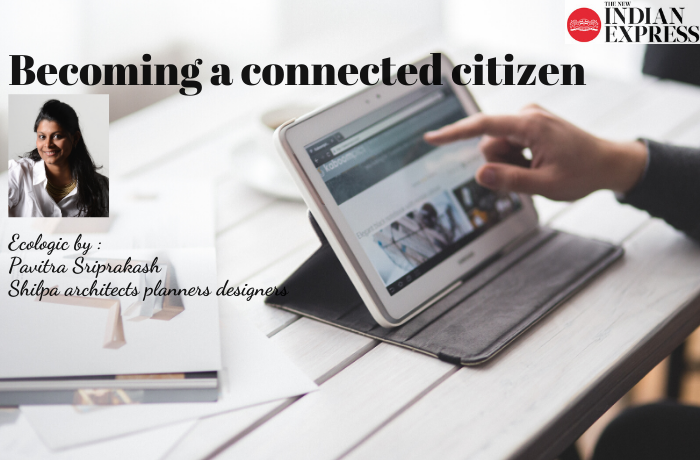29-Jan-2020: Pavitra Sriprakash, Director and Chief Designer at Shilpa Architects Planners Designers writes a weekly column on Sustainability for The New Indian Express titled “ECOLOGIC”. This week’s article is about digital app for citizen participation.
Full article below: (Also available at The New Indian Express Website)
Becoming a connected citizen
We are living in an age where our government is extensively engaging citizens through digital technologies. With open channels for citizen participation across various sectors and interest groups, it’s only a matter of time when digital technologies become the lifeblood of our cities. Technology can rapidly transform cities once they are wired to be ‘smart’. From information and communications technology (ICT) to the Internet of Things (IoT), in which objects are connected to the Internet — any object can become part of an intelligent urban network, collecting data through sensors, analysing them and giving elected officials and city administrators an unparalleled understanding of the infrastructure and services of their city.
Part of what it takes for cities to become ‘smart’ involves the framework through investments in the information and communications technologies that becomes the basis of everything — from the power grid to the transportation systems. But this is only one half of the story. Equally important are the kinds of technologies that enable stakeholders — residents, visitors, daily commuters and tourists — to derive more value from their cities’ infrastructure and services and further still contribute to their planning and design.
A study was published by The Economist Intelligence Unit (EIU), in order to investigate how citizens and businesses in 12 diverse cities around the world (Barcelona, Berlin,
Buenos Aires, Chicago, London, Los Angeles, Mexico City, New York City, Rio de Janeiro, Shanghai, Singapore and Toronto) envision the benefits of smart cities. The two big trends predicted by the study are the ‘The connected city’— how digital technology can be a catalyst for urban transformation, and ‘The fixable city’ — near real-time feedback on urban services. The study goes to show that the most popular communication tools between city governments and citizens are social media (44 per cent) and e-mail (42 per cent). To push this boundary further, it is possible in smart cities to engage citizens for direct feedback on services or submit their ideas for improvements with just a smartphone and some apps!
According to the EIU survey, 36 per cent of respondents cite telecom services as the digital technology that has impacted their lives over the past three years, followed by transportation (31 per cent), crime prevention (21 per cent) and social services such as healthcare and education (21 per cent). Interestingly, despite the differences in challenges and the varying levels of economic development, the responses show that across cities the same areas have seen improvements from the use of digital technologies — going to show that urban issues are somewhat consistent…the world is flat!
We have all walked past overflowing garbage, feeling helpless, shrugging it off in dismay and walking on. A few engaged citizens may have gone through the trouble to put in a call to their municipal authorities to complain, but this required effort to track down the right department and phone number. In many cities across the world including Chennai, this has already changed! Today, using the Namma Chennai App by the Greater Chennai Corporation residents in these can register complaints with the Corporation by sending in a picture or description of anything from a broken sidewalk to a street-light outage. Start today, download the app and become a connected citizen of the city of Chennai.



